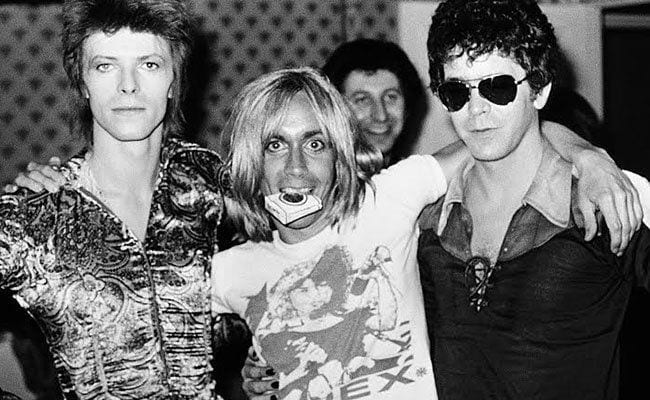
“A certain hunger comes over me when I pick up a camera. Like a vampire!” — Mick Rock
From the otherworldly cover of Lou Reed’s Transformer (1972) to the Marlene Dietrich-inspired poses of Freddie Mercury, photographer Mick Rock is responsible for some of rock ‘n’ roll’s most iconic images.
First time documentarian, Barney Clay, brings Rock’s artistic obsession into spectacular relief in SHOT! The Psycho-Spiritual Mantra of Rock. This bombastic title befits a man who, at the tender age of 24, was already David Bowie’s personal photographer. Rock penetrated glam rock’s inner circle in the early ‘70s and then rode that reputation through punk, new wave, and glam metal in the ‘80s.
“My pictures became my identity,” confesses Rock, who so closely identified with his photographic subjects that he became a rock star in his own right. He also suffered a similar fate to many of the golden gods he captured; rocketing into the cultural consciousness only to flame out in a blaze of drug-fueled debauchery.
Clay uses Rock’s massive heart attack in 1996 as a jumping off point into his past. From his cold slab in a hospital operation suite, Rock revisits the faces that shaped his life and career. He recalls an unhinged Syd Barrett, unceremoniously sacked from Pink Floyd just a year earlier, painting the dirty floorboards in his flat during a chaotic photo shoot. The savvy Rock recognizes the sad irony of launching his own career on the shoulders of a man descending into oblivion.
Not that Rock learned any lessons from his famous benefactors. The victim of three heart attacks before the age of 50, Rock, by his own admission, “was drawn to the good, the bad, and the wicked.” He cavorted with Bowie in Berlin, Reed in New York City, and cocaine fiends wherever he could find them.
And what amazing photos he took!
Bowie, on his knees, biting a bandmate’s guitar; a drug-addled Rod Stewart, Mick Jagger, and Ron Wood confronting police in their hotel room; Lou Reed and David Bowie kissing each other on the lips! Rock’s inability to maintain a professional distance ingratiated him to the fragile egos behind the larger-than-life personas. By embracing the rock ‘n’ roll lifestyle, he was granted unfettered access to the excess, and he responded by making everyone look impossibly glamorous.

Mick Rock
Rock knowingly exploited this symbiosis to score everything from drugs to women. It’s hard to imagine Rock, who now resembles an exhausted hybrid between Tim Burton and Howard Stern, canoodling with Debbie Harry and Joan Jett, but he’s got the pictures to prove that rock ‘n’ roll ladies weren’t shy about flashing their assets.
He’s also got lots of audio recordings to share.
Cassette tapes and cocaine were an irresistible combination back in the ‘70s, and Rock records some wonderfully candid exchanges with Reed and Bowie. There are moments of sublime silliness, such as Reed instructing Rock on the proper sequence of buttons required to record on the tape deck. More importantly, there’s insightful commentary about the vacuous nature of stardom from two men (Bowie, in particular) who feel both unjustly praised and unfairly pigeonholed. Reed bristles at fans that attach misguided sentimentality to his haunting anthem, “Heroin”.
Like the drug, “by the time (the song) hits you, it’s too late.”
Even more enlightening are Reed’s disparaging observations on the burgeoning punk rock scene in New York City. Calling the Ramones “dirty” and dismissing their songs as too simplistic, Reed proves that elders in all stations of life, no matter how lofty, will always look down their noses at the kids. Like Rock’s candid photos, these recordings both humanize and mythologize his subjects; their obvious flaws concealed by the rare glimpse into their mysterious worlds.
When luminaries like Reed, Bowie, and Iggy Pop recede, however, Clay has trouble finding a compelling center for his film. Rock’s photos of modern artists, including Snoop Dogg and Lenny Kravitz, are equally brilliant, but they lack the same mythos surrounding his earlier work. “I was a child of my time,” Rock explains, and those times preceded the immediacy of a digital age that delights more in destroying heroes than building them up.
Clay jazzes up Rock’s journey to redemption with plenty of visual flourishes. For Rock, the hospital gurney becomes a spiritual purgatory, where the beckoning ghosts from his past must reconcile with his desire to stick around. This haunting but ultimately uninteresting sequence includes the echoes of familiar songs from Bowie and Reed, as well as a psychedelic freakout worthy of the Star Gate in 2001: A Space Odyssey.
But it always comes back to the pictures.
Not only do Mick Rock’s pictures punctuate one man’s quest for acceptance and brilliance — they capture the essence of a world in flux. As the Summer of Love ends and the innocence withers, new figures fill the void with an unprecedented cynicism. Rock, his camera “using him as a conduit”, documents the transition with startling honesty and clarity. SHOT! The Psycho-Spiritual Mantra of Rock is a loving tribute to the talented artist who not only photographed sex, drugs, and rock ‘n’ roll, he lived it.


![Call for Papers: All Things Reconsidered [MUSIC] May-August 2024](https://www.popmatters.com/wp-content/uploads/2024/04/all-things-reconsidered-call-music-may-2024-720x380.jpg)



